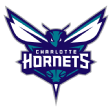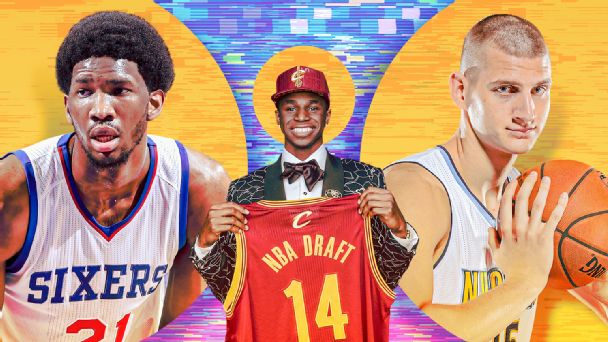Now a decade old, the 2014 NBA draft was one of the more memorable drafts with reigning MVP Joel Embiid going third and Nikola Jokic headlining a second round that’s hard to beat in terms of talent and impact on the league.
The Cleveland Cavaliers kicked off the draft by selecting Andrew Wiggins first overall and the Milwaukee Bucks selected Jabari Parker at No. 2. If those teams could go back now, who would they select? And how would that have influenced the past 10 years in the NBA?
ESPN’s Jeremy Woo redrafted the 2014 draft lottery with help from Kevin Pelton and the WARP metric. So, with the past decade in the rearview, who lands at No. 1 and which 2014 top 10 picks fall out of the lottery?
Wins above replacement player (WARP) is a box-score metric that factors in a player’s contributions on offense and defense to approximate their value as compared to a replacement-level player at the same position signed for the minimum salary.

1. Cleveland Cavaliers
Nikola Jokic | C | Mega Vizura | WARP: 120.4
Originally selected No. 41 by the Denver Nuggets
There was no way to know Jokic at the 41st overall pick would become arguably the single highest-value draft pick in modern NBA history. He was a productive teenage prospect in Serbia, but concerns about his body type and athletic ability hurt his broader appeal in the draft. The Nuggets’ front office keyed in on his passing ability and flashes of all-around offense and decided to take a chance on him in the second round, bringing him over to the NBA a season later after he earned the Adriatic League MVP.
What ensued went on to define this era of the NBA : Jokic gradually got his body right, expanded his game and became the focal point of the Denver franchise, making his first of six All-Star games in 2019, winning back-to-back MVPs in 2021 and 2022 and leading the Nuggets to the title in 2023. He’s become arguably the most dominant player of this era and one of the best passers in league history. His productivity and longevity to date has supported that argument, reflected by the massive gap in WARP between Jokic and the No. 2 player in this redraft.

2. Milwaukee Bucks
Joel Embiid | C | Kansas | WARP: 69.8
Originally selected No. 3 by the Philadelphia 76ers
In most other redrafts there might be a stronger argument for Embiid, the 2023 MVP and seven-time All-Star, at No. 1. And when he’s been available, he’s been one of the NBA’s best players, evolving into an efficient and highly productive force at center who can score from all over the floor. While an obvious choice at No. 2 by any measure or metric, his statistical résumé is harmed by the fact he’s played just 433 games in eight seasons due to various injuries — he sat out the 2014-15 and 2015-16 seasons due to complications from a broken bone in his foot.
That foot injury caused Embiid to fall to No. 3 in the 2014 draft. The Cavaliers were prepared to take him first before news of his stress fracture but Embiid had surgery the week of the draft, creating enough medical concern to send him down two spots to the 76ers, who were prepared to wait out his recovery amid a long-term rebuild via tanking. The organization eventually benefitted from the risk, with Embiid becoming the face of the franchise and one of the NBA’s best players.

3. Philadelphia 76ers
Clint Capela | C | Elán Chalon | WARP: 50.6
Originally selected No. 25 by the Houston Rockets
Viewed as a raw but intriguing developmental pick entering the draft, Capela quickly blossomed in Houston. The Swiss prospect emerged as the team’s starting center in his second season and developed into one of the NBA’s most productive bigs. His best stretch came in the midst of the Rockets’ successful run building around James Harden, where he was asked to sprint the floor, screen, protect the rim, rebound and finish plays — a workmanlike role that laid the groundwork for plenty of centers over the past decade. While never an All-Star, Capela has averaged a double-double each of the past seven seasons and enjoyed a strong career as a highly reliable role player on winning teams. His longevity helps his statistical case as the third pick in our redraft, and stands as excellent value for a 25th overall selection.

4. Orlando Magic
Zach LaVine | SG | UCLA | WARP: 46.1
Originally selected No. 13 by the Minnesota Timberwolves
LaVine averaged just 9.4 points coming off the bench in his lone season at UCLA and was viewed as a high-risk, high-reward prospect entering the draft, with his unique athleticism and flashes of guard skills portending major scoring upside. His assessment turned out to be accurate: It did take LaVine a while to blossom in the NBA, not turning into an All-Star level player until arriving in Chicago in his fourth season as the centerpiece of Minnesota’s trade for Jimmy Butler. LaVine came back strong after tearing his ACL the previous season and went on to make the All-Star team in 2021 and 2022, turning into one of the league’s better scorers during those years. Had he not missed as much time with injury (he’s logged just 580 games in 10 seasons), he likely comes off the board ahead of Capela, but he’s returned strong value as the 13th pick regardless.

5. Utah Jazz
Julius Randle | PF | Kentucky | WARP: 38.1
Originally selected No. 7 by the Los Angeles Lakers
Randle has filled the stat sheet for much of his career, with averages of 19.1 points and 9.4 rebounds on reasonable efficiency, earning three All-Star selections, two All-NBA selections and a most improved player award in 2021 — all with the Knicks. He’s also been turnover-prone and hasn’t offered much on the defensive end throughout his career, but his combination of strength and all-around scoring has made him a matchup problem. While often maligned for his periodic inconsistency, Randle has still become one of the more decorated players from this draft class.

6. Boston Celtics
Aaron Gordon | PF | Arizona | WARP: 35.8
Originally selected No. 5 by the Orlando Magic
It took a trade to Denver in 2021 for Gordon to unlock his full potential as a player, as his first seven seasons in Orlando were marred by offensive inefficiency and poor shot selection. He embraced a complementary situation after joining the Nuggets and played a big role in their 2023 title while providing versatile defense and benefiting greatly from Jokic’s playmaking ability. Gordon’s reinvention as a winning player doesn’t always show up in the stat sheet — an argument for him ahead of a player like Randle could be made — but he’s turned into a very solid player after landing on an ideal team. Gordon’s career shows how much situational factors matter in player development and performance. Sometimes, players take a while.

7. Los Angeles Lakers
Bogdan Bogdanović | SG | Partizan Belgrade | WARP: 31.8
Originally selected No. 27 by the Phoenix Suns
Bogdanović played three seasons in Turkey with Fenerbahçe before joining the Sacramento Kings, who acquired his rights in a 2016 draft-night trade that sent Marquese Chriss to Phoenix. He immediately stepped in as a viable rotation player, making 52 starts his rookie season and earning a big free agent contract from the Hawks in 2020 after a botched sign-and-trade between Sacramento and Milwaukee. A 38% career 3-point shooter whose averaged double figures in each of his seven NBA seasons, his consistent production has made him one of the better players out of this draft and a nice value pick at No. 27, though the Suns didn’t benefit.

8. Sacramento Kings
Marcus Smart | PG/SG | Oklahoma State | WARP: 31.0
Originally selected No. 5 by the Boston Celtics
It didn’t take long for Smart to become part of the fabric in Boston, with his all-out style and standout defense turning him into a useful player despite the fact he’s never been an efficient scorer. The 2022 Defensive Player of the Year and three-time All-Defensive team selection became a vital player for the Celtics before being sent to Memphis last summer in a three-way deal ahead of the season. He missed much of the campaign due to injury, but remains one of the league’s more unique role players, correctly coming off the board in the top 10 in 2014.

9. Charlotte Hornets (via DET)
Jordan Clarkson | PG/SG | Missouri | WARP: 26.5
Originally selected No. 46 by the Los Angeles Lakers (via trade with WAS)
It may come as a surprise that Clarkson has logged more games than any player in this draft class after falling to the 46th pick on draft night. He benefited from finding minutes early in his career amidst a Lakers rebuild, carving out a niche with his scoring before settling into a useful role with the Cleveland Cavaliers and now the Utah Jazz. Clarkson’s college numbers — he shot just 28% from 3 his junior season at Missouri — didn’t leap off the page, and he’s been a 33% shooter from long range in the NBA. But his ability to create shots and provide a spark when called upon has considerable value: He was rewarded with Sixth Man of the Year honors in 2021, and has earned a pair of nice contracts in Utah.

10. Orlando Magic (via trade with PHI)
Spencer Dinwiddie | PG | Colorado | WARP: 26.1
Originally selected No. 38 by the Detroit Pistons
Dinwiddie spent most of his first two seasons in the G League before catching on with the rebuilding Brooklyn Nets in 2016, where he gradually carved out a role. A season-ending ACL tear in 2020 preempted a sign-and-trade to the Washington Wizards and he’s bounced around the NBA since, most notably a quality stint with the Dallas Mavericks. Dinwiddie hasn’t been the most consistent shooter for much of his career, but he provides positional size and enough scoring and playmaking ability to help soak up minutes as needed. He turned out to be one of the better values in this draft class relative to draft slot.

11. Chicago Bulls (via trade with DEN)
Jusuf Nurkic | C | Cedevita Zagreb | WARP: 25.7
Originally selected No. 16 by the Denver Nuggets (via trade with CHI)
Acquired by the Nuggets through a draft-night trade in which the Bulls traded up for Doug McDermott, Nurkic was famously supplanted by the other European center Denver selected 25 picks later and was dealt to the Portland Trail Blazers in 2017. Nurkic had some solid years in Portland, where he established himself as the starting center before a broken leg sidetracked him. His size, coordination, touch and passing make him a unique offensive player, and while not a prolific rim protector, Nurkic is also a decent defender. Nurkic has generally been a useful contributor on playoff-caliber teams when healthy, returning good value on his original selection.

12. Philadelphia 76ers (via trade with ORL)
Kyle Anderson | SF/PF | UCLA | WARP: 22.2
Originally selected No. 30 by the San Antonio Spurs
Anderson was a nice value pick for San Antonio, developing into a versatile connective frontcourt player by the end of his rookie contract and providing useful seasons ever since for the Memphis Grizzlies and Minnesota Timberwolves. His ability to play either forward spot, create opportunities with his passing and space the floor at a passable rate have made him a useful rotation player. Anderson has started 315 of 696 NBA games — a pretty good return for the last pick of the first round.

13. Minnesota Timberwolves
Jerami Grant | SF/PF | Syracuse | WARP: 16.0
Originally selected No. 39 by the Philadelphia 76ers
Grant was viewed as a raw but promising prospect at Syracuse, where his modest production and underdeveloped skill set caused him to fall into the second round. The rebuilding 76ers were able to give him early playing time and he gradually turned into a useful frontcourt player for the Oklahoma City Thunder before moving around the league, most recently signing a $160 million contract with Portland. While not a great rebounder for his position, Grant’s scoring ability, physical tools and energy eventually turned him into a good NBA player, particularly after he developed into a reliable 3-point shooter in the middle of his career, allowing him to play as a stretch four.

14. Phoenix Suns
Joe Harris | SG | Virginia | WARP: 15.0
Originally selected No. 33 by the Cleveland Cavaliers
Another nice value pick in a draft that featured several quality second-rounders, it took the sharpshooting Harris a few years to catch on, eventually emerging as part of a rebuilding Brooklyn Nets team that kept him around for seven seasons. A career 43.6% 3-point shooter who has led the league twice in that category, Harris’ ability to stretch defenses, take care of the ball and play competent defense helped him carve out a solid career before a pair of ankle surgeries hampered his availability. He was most recently waived by the Detroit Pistons in February.
Next five out
Andrew Wiggins | SF | Kansas | WARP: 13.5
Originally selected No. 1 by the Cleveland Cavaliers
It’s worth noting that the 15th player on our WARP rankings is No. 1 pick Wiggins, which may or may not come as a surprise. Wiggins has played more minutes than anyone in the 2014 draft and scored the second-most points, but his production has often been critiqued as empty calories, which is supported to some extent by his WARP output and average scoring efficiency.
Elfrid Payton | PG | Louisiana | WARP: 13.0
Originally selected No. 10 by the Philadelphia 76ers (traded to the Orlando Magic)
Dwight Powell | PF | Stanford | WARP: 12.7
Originally selected No. 45 by the Charlotte Hornets
Gary Harris | SG | Michigan St. | WARP: 12.7
Originally selected No. 19 by the Chicago Bulls (traded to the Denver Nuggets)
Dario Saric | PF | Cibona Zagreb | WARP: 11.5
Originally selected No. 12 by the Orlando Magic (traded to the Philadelphia 76ers)
ESPN NBA Insider Kevin Pelton contributed to this story.


